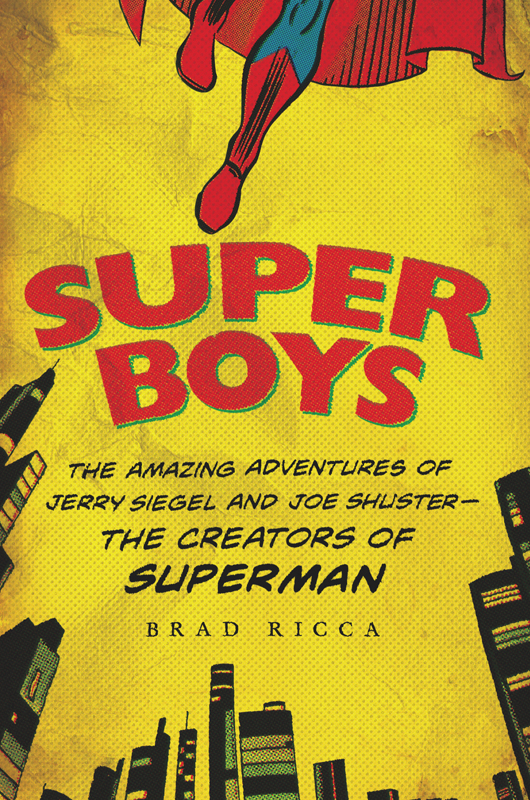
The author and publisher have provided this e-book to you for your personal use only. You may not make this e-book publicly available in any way. Copyright infringement is against the law. If you believe the copy of this e-book you are reading infringes on the authors copyright, please notify the publisher at: us.macmillanusa.com/piracy.
For my dad
Contents
Part One:
Part Two:
Part Three:
It was dead!
Stiletto Vance discerned that at once.
Confronting us, he informed me, is evidently an insoluble mystery. Who murdered this man? Why?
I shook my head, puzzled, and confessed my perplexity.
There is a solution!must be oneand I shall find it! he declared confidently.
Jerry Siegel, The Glenville Torch
March 12, 1931
Introduction
I am at Cleveland City Hall waiting for a copy of a birth certificate that is not mine. The final typed draft of this bookmarked-up, messy, and almost donelies in an immense pile on my desk at home. But there is one more fact to check, so I am downtown, on a gray October day. Numbers and dates and spelling: these things are important. These are places to start from.
This book is not only a story but it is about one. The story we all somehow absorb of a child rocketed to Earth from a dying planet. The orphan grows up with incredible powers and is embraced by an Earth he is sworn to protect. He likes a girl who doesnt give him a second glance. He wears a red, flowing cape, but also hides in plain sight. It is a silly story sometimes; silly in the face of what the world sometimes shows to us, yet it has given hope and solace to generations. That is important, too.
I am still waiting for the birth certificate and am now worried about how much time is left on my parking meter. To my right, on the black benches, two employees are trying to help an elderly woman get a death certificate for her late husband. The woman doesnt understand why the insurance company is making her do this. She came here on the bus. She is crying. At the snack stand, which sells candy, pop, and cheeseburgers, the clerk closes his eyes. On the small TV mounted over the wrought-iron cashiers cage, local junior high flag football is being played. A kid catches a bomb and sails into the end zone.
When my dad would tell me that Superman was created here in Cleveland, I never really believed him. We took excursions downtown from the suburbs and explored it like it was some once-great civilization, with huge parts of it empty and exploded away. There were secrets and stories here, of a past that might once have been golden. As I grew up, I began to see why he might be right. At the time I am writing this, our football team has not won a game in eleven months. Our baseball team has not won a championship since 1948. The newspapers are filled with bad things. The air is getting cold and the skies will be overcast for the next six months. When we see a patch of blue, we look up and stare.
Superman is not real.
But here, at some point, he somehow was.
This story is not like the others. This story is not just about Superman but is about two men and their work, both in public and in secret, over a significant portion of the twentieth century. This is about what they really did, not what we wanted them to. That is important, too.
I never knew Jerry Siegel and Joe Shuster. I am not even remotely related to them. But their storycreating the impossible Superman as teenagers during the Great Depressionis one that somehow resounds through all of us with a soundtrack we can almost always just hear. In the comics, Superman is always looking for secrets to his heritage. That is no coincidence. We all want to know where we come from. The same goes for our dreams and fictions. Why have these characters lasted? What can they tell us? Most people may claim to like Batman better, but it is Superman who measures the best of us. We want to know why.
But how? Not only through dusty facts and forgotten artifacts but through the very actions that stole their hours. The truth is, Jerry and Joe told us their own secrets in the comics and stories they puzzled over for decades. We have been distracted by half-remembered tales when the answer has been right in front of us the whole time. The work: that is their secret identity.
Superman is not real. But the facts I discovered are just as unbelievable: a mystical cult, a bald, power-mad millionaire, a bulletproof strongman, the real Lois Lane, and a writers unlikely, secret service to his country. I found out that the first Superman story was stolen. I not only learned the true cause of Jerrys fathers death but who the culprits could be. How? I live in Cleveland; I went to all the places and read all the comics. It took a long time. I read Jerrys last, unpublished story and my spine, as the comics always promised, actually tingled. And I discovered someone real who, by all accounts, is supposed to be a lie. And somewhere in this book is who I think Superman really is. But thats my interpretation; you have to find yours.
They call my name and I pay $25 for a birth certificate of someone I did once meet, but am not related to. I open it and pause. It is a new date and a new spelling, one that sounds suspiciously like a famous Superman character. This is how it starts: how truth can become imagination, and thus, a window into a hopeful world right next to our own. But creation has a cost.
Superman isnt real. But sometimes we wish he could be.
This is the story of that wish coming true.

Prologue
I N THE BACK OF THE STORE, the white-haired man was reading the late edition of the city newspaper. He pressed it flat, like a map, over the long cutting table. The sheets of ink reflected nothing of the lights above. Outside, a fat, black lake of a thunderstorm was brewing over the flickering streets of Cleveland, Ohio. The clothing store, small and narrow, was on the corner of Central Avenue and East Thirty-first Street. Because of the weather, it was almost empty, as were most of the stores that night. But there was money to be made, the owner thought, so his lights were lit, still hopeful for some customers. It was June 2, 1932.
Inside, clothes and hats filled every corner and table. A slight wisp of smoke curled below the overhead lamp. This was not the glass-counter fantasy world of Higbees or Taylors, the massive downtown department stores with their endless displays of merchandise. There were no men in vests working the elevators or pretty girls spritzing strong perfume. There was only this dark building with a white, roughly painted sign that read, 2nd Hand Clothing. The place was exactly what it claimed to be. The rain began to fall.
The store had a smell like any fathers closet: dark blazers, thick wool pants, and brushed-cotton shirts all hung from golden hooks. They all had stories, these suits and slacks, ties and bracers, sliding up and down the wooden dowels. But most of their stories were sad ones, because these clothes were sometimes sold to pay for things like rent or birthday presents. Many were even sold off the backs of the dead.
The white-haired man reading the paper was the owner, a sturdy man with a frowning mouth. In a corner near the front, a thin black man shuffled through some loose shirts and ties. The clock read eight oclock. The owner hoped the man would buy something so he could close the store and go home.









